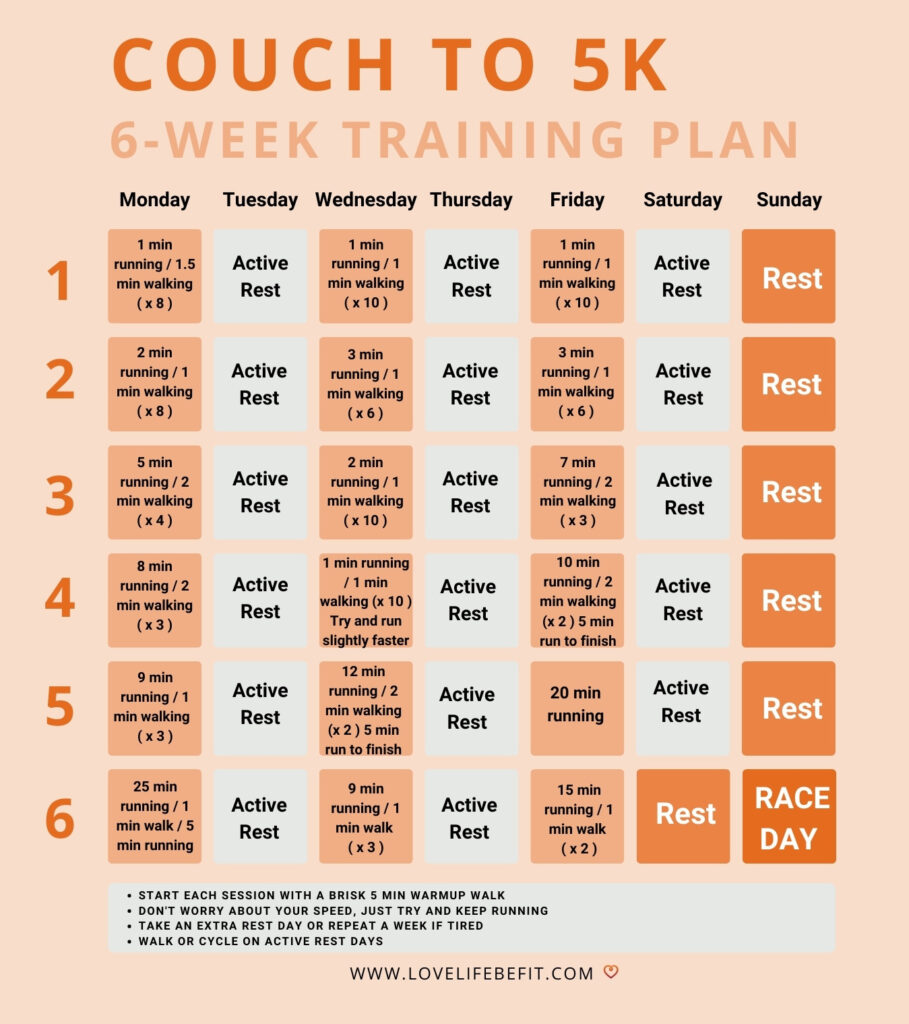Running For Weight Loss Plans: Training Guides + Workouts
Most people start running to lose weight. With so many wonderful reasons to run – from making new friends to taking part in challenges, improving health and fitness, or just enjoying being out in the fresh air, losing weight is the number one reason people take up running. That’s probably why you’re here looking for a running for weight loss plan.
The popularity of running for weight loss makes sense: it’s a great way to burn calories and most people lose weight following a running program. But be warned: the relationship between weight loss and running gets complicated.
Read on to find out how much weight can you lose running and about all the pros and pitfalls of following a running for weight loss program, get the best running workouts for losing weight plus our free 6-week beginner running plan for weight loss.

Can You Lose Weight Just By Running?
Yes, you can! Before we get into the nitty gritty of burning calories just be reassured that most people successfully use running workouts as part of their weight loss journey.
It’s extremely difficult to lose weight and keep the weight off permanently without exercising. You don’t have to run. It’s best to find a physical activity you enjoy and can still see yourself doing in 5 or 10 years’ time.
But running is easily accessible – you just need some good running shoes plus a sports bra for women and off you go – plus it burns more calories than most other forms of exercise.
How Running For Weight Loss Works
All weight loss is about creating a calorie deficit.
Yes this might sound simplistic and we’ll get into the pitfalls of weight loss plateaus later, but losing body weight is about eating fewer calories than the calories you burn daily.
Exercise is just one way of burning calories – just breathing, regulating your temperature, and even eating food uses energy.
Find out more and calculate your typical daily energy expenditure using our calories burned calculator.
If you want to lose weight it’s important to keep your food intake below your daily calorie requirements. For example, if you’re eating 3000 calories a day and your body only needs 2000 calories for daily energy expenditure – running won’t be enough to create a calorie deficit.

Losing Weight By Running
To make running for weight loss work, your runs need to boost your energy expenditure above your daily calorie requirements.
Start running and drop all your usual activities such as walking to the shops or gardening and your total energy expenditure may not increase.
The other side of the equation is your diet. If you stop off at a bakery on the way back from your run and treat yourself to a cream cake – all those extra calories burned running will quickly be replaced.
Running For Fat Loss – Does Running Burn Fat?
When people talk about weight loss, they normally mean losing body fat. It’s excess stored body fat that makes your clothes fit badly and carries all the health risks.
Lean muscle mass helps to keep you mobile in later life, and strong core and leg muscles are essential if you want to be a better runner.
But is running good at burning fat? Yes, it is!
Running is one of the best ways of burning fat and uses fat to fuel your workout session. That’s why runners’ bodies typically have a low body fat percentage.
If you only diet and don’t exercise you’ll lose muscle mass as well as body fat. Your body breaks down muscle mass to access the energy it needs for daily functions.
Related post: Fat vs. Muscle: How Does It Affect Your Weight?
Running For Weight Loss Calculator
This running calories calculator tells you how many calories you burn for different running distances and running speeds.
Calories burned per mile will depend on many factors such as your body weight, speed, distance run, running terrain, and incline.
Related post: How Many Calories Does Running Burn Per Mile?
How Much Should I Run To Lose Weight?
A typical target for weight loss is running 5 miles a day. That’s approximately 500 calories if you’re running at a moderate pace.
Be aware that 5 miles a day will be too far for most beginner runners. Find out more: How Much Should I Run To Lose Weight and How Much Should I Run According To My BMI?
Best Running For Weight Loss – Fast Or Slow?
Fast running burns more calories than running slowly.
For example, if a person weighing 150 pounds runs 3 miles at a 10 mph pace for 30 minutes, they will burn 350 calories.
If the same person runs at a pace of 8 mph for the same duration of 30 minutes, the calories burned running increases to 404. That’s a 15% increase.
But this example compares someone running faster but for the same running duration of 30 minutes. The same person running 3 miles at a pace of 8 mph will complete the distance in 24 minutes and burn just 323 calories!
Why is it less? Because you’re spending less time running and time spent exercising is an important factor in calorie burn. Getting around your regular running route faster may not improve your weight loss efforts.
Related post: Walking For Weight Loss Plan – Fat Busting Workout Schedule
Fat Burning Myth
There’s a hugely popular idea that if you exercise at a lower intensity, in the fat-burning zone, most of the calories burned will be from fat instead of carbohydrate (glycogen) stores.
The zone is between 64 and 76% of your maximum heart rate (MHR) defined as moderate-intensity physical activity.
Exercising in this zone will burn a higher percentage of calories from fat compared with high-intensity exercise but your total calorie burn will be lower. So the overall number of calories burned from fat may not be any different.
After exercising, when you have your next meal, the calories consumed will replenish both your glycogen and fat stores – if your glycogen stores have been run down during intense training these will be topped up first. Excess calories will be stored as fat.
If your exercise session has mainly been fuelled by fat burning, your glycogen stores will already be full and more calories will be stored as fat.
The result is the same – you still need a calorie deficit to lose weight.

Interval Running For Weight Loss
Complete beginner running programs, such as Couch to 5K, use run/walk intervals to ease you into a running program. Think of interval running as the next step – you’re alternating fast and slow running to increase intensity.
The main aim of interval training is to improve a runner’s aerobic capacity known as VO2 max – the amount of oxygen you can breathe in while exercising as hard as you can. The more oxygen you can inhale, the more energy your body can use, and generally, the faster you can run.
High Intensity Interval Training (HIIT)
Running short fast intervals, 80 to 90% of maximum effort can also help with weight loss.
Instead of focusing on how far you can run, these more intense workouts have a lot of advantages:
- If you only have a short amount of time to train, you can burn more calories.
- High-intensity training will significantly boost your metabolism for several hours after your workout. Your muscles are working harder during intense exercise and use a lot of energy post-exercise to recover and repair.
- Intense training builds muscle mass and muscle cells use more energy at rest than fat cells. Muscle cells also help to regulate blood sugar levels – good for those sweet cravings!
How Fast Should You Run For Weight Loss?
Running at high intensity may burn calories at a higher rate but if you’re a beginner runner you need to ease into a running program.
Start off running at high intensity from the word go and you’re likely to end up injured.
The risk of injury is even higher if you’re an older runner, you haven’t exercised in years or done any strength training or you’re carrying more than a few pounds of excess weight.
NOTE: It’s best to get checked out by a medical professional before starting a new exercise program.
As a new runner, set your running pace at a level you can maintain 4 to 5 times a week. It’s regular running that gets results. If you’re a slow runner that’s okay! You can still lose weight if you run at a slow pace.
The normal advice is to build up your running for 3 to 6 months before adding more intense running workouts such as interval training.
But if you’re relatively young and already used to exercise, try these interval training and running workouts – just be cautious. If you feel any persistent niggles, take some time out of training and let your muscles recover.
Related post: How Fast Should I Run?
Running workouts to lose weight
These running workouts are mainly aimed at runners who’ve been running for at least 6 to 8 weeks – preferably 3 to 6 months if you’re an older runner, carrying a lot of excess weight, or starting from a very low fitness level. Build up some leg strength and resilience to running injuries first.
The workouts are ideal for existing runners who’ve let things slip a bit! Maybe you’ve been running for years in your comfort zone and the pounds have crept on. These workouts will help you regain your running form.
Add one to two sessions a week to your current training plan or follow the 6-Week Running Plan To Lose Weight at the end of this post.
Aerobic Intervals
These intervals are high-intensity. You’ll be sprinting at an effort level of RPE of 8 or 9 for short intense bursts and dropping back to light recovery intervals at RPE 3 to 4. The work phase or sprint will be hard but don’t set off so fast that you’re unable to complete the session. Talking will be almost impossible and your breathing will be labored.
For the recovery time, jog or walk to get your breath back.
- Warm-up 10-15 minutes easy run
- Sprint for 20 seconds (RPE 8 to 9)
- Walk or jog recovery 40 seconds (RPE 3 to 4)
- Repeat 10 times
- Cool-down 5-10 minute easy run.
Total session time: 25 to 35 minutes
As you get fitter, gradually increase the number of repetitions. Aim for 20!
Intervals At 5K Race Pace
For these intervals run at the average pace of your 5K personal best. You’re aiming for an RPE of 8 where it’s hard to say more than a few words as you run.
- Warm-up 10-15 minutes easy run
- Run hard 4 minutes
- Walk or jog recovery 4 minutes
- Repeat 4 times
Total session time: 37 to 42 minutes
Hill Repeats
Unless you’re already used to running up hills, these sessions will be particularly hard. Don’t try them unless you’re already running regularly – at least 3 to 4 times a week.
Find a hill that’s not too steep – you want to be able to run reasonably fast. A 5-10% grade is best.
- Warm-up on the flat 10-15 minutes easy run
- Run uphill for 60 seconds at 5K pace (RPE of 8)
- Walk or jog back down 1-2 minutes
- Repeat 4 to 8 times
- Cool-down 5-10 minute easy run on the flat.
Total session time: 23 to 49 minutes
Try varying the length of the hill repeats from 45 to 90 seconds. For 90-second sessions aim to run at 10K pace (RPE of 7)
Continuous Run At 10K Pace
Tempo running or running at a constant pace can seem the hardest session in these workouts. You’re running at your 10K race pace (RPE of 7) for 3 miles (5K). It’s a challenging pace – so don’t set off too fast.
- Warm-up 10-15 minutes easy run
- 3 miles at 10K race pace (approximately 30 minutes)
- Cool-down 5-10 minute easy run.
Total session time: 45 to 55 minutes
Cross Training
Adding cross training to your running plan compliments your running and helps you to train harder during the week without picking up overuse injuries.
Read more about the benefits of cross training and why we strongly recommend it. Aim for 1 to 2 cross training sessions per week.
Related post: The Best Cross Training For Runners
Strength Training
As a runner, strength training is important to make you more resilient and improve your running efficiency. It also helps with weight loss.
Stronger muscles increase your metabolism and the number of calories you’ll burn daily.
Add 2-3 short strength training sessions to your weekly training plan. We recommend these must-do bodyweight exercises for runners.
6-Week Running Plan To Lose Weight
We’ve included two very different running plans for weight loss. The first running for weight loss plan Option A is for complete beginners. It’s a variation of our Couch to 5K in 6-weeks plan but adds extra cross training and strength training sessions. The aim is to train 5 days a week for maximum weight loss.
Related post: How To Start Running When Overweight
Option B is a 6-week running to lose weight plan for more experienced runners. Make sure you have a running base of at least 6 to 8 weeks before starting the plan and you’re able to run continuously for 30 minutes. If you’re an older runner, you haven’t exercised in years or you’re carrying more than a few pounds in excess weight, make sure you have a running base of at least 3 to 6 months first.
Option A 6-Week Beginner Running Plan For Weight Loss
Follow the Couch to 5K 6-Week Training Plan but add two 20-30 minute cross training sessions plus two 10-minute strength training sessions per week on your active rest days. You can double up cross training and strength training.
The training plan ends with a 5K race for extra inspiration!

Option B 6-Week Running To Lose Weight Plan For More Experienced Runners
Make sure you respect the rest days and take 2 rest days per week but feel free to swap around the training sessions to suit your schedule. Refer to the above running workouts section for training session details.
Week 1
- Monday – Rest Day
- Tuesday – Aerobic intervals including warm-up and cool-down
- Wednesday – Cross training 20 minutes + 10 minutes strength training
- Thursday – Continuous run at 10K pace
- Friday – Rest Day
- Saturday – Cross training 20 minutes + 10 minutes strength training
- Sunday – Long run 3 miles (RPE 5)
Week 2
- Monday – Rest Day
- Tuesday – Intervals at 5K race pace including warm-up and cool-down
- Wednesday – Cross training 20 minutes + 10 minutes strength training
- Thursday – Continuous run at 10K pace
- Friday – Rest Day
- Saturday – Cross training 20 minutes + 10 minutes strength training
- Sunday – Long run 3.5 miles (RPE 5)
Week 3
- Monday – Rest Day
- Tuesday – Aerobic intervals including warm-up and cool-down
- Wednesday – Cross training 20 minutes + 10 minutes strength training
- Thursday – Easy run 2 miles
- Friday – Rest Day
- Saturday – Cross training 20 minutes + 10 minutes strength training
- Sunday – Long run 4 miles (RPE 5)
Week 4
- Monday – Rest Day
- Tuesday – Hill repeats including warm-up and cool-down
- Wednesday – Cross training 20 minutes + 10 minutes strength training
- Thursday – Continuous run at 10K pace
- Friday – Rest Day
- Saturday – Cross training 20 minutes + 10 minutes strength training
- Sunday – Long run 5 miles (RPE 5)
Week 5
- Monday – Rest Day
- Tuesday – Aerobic intervals including warm-up and cool-down
- Wednesday – Cross training 20 minutes + 10 minutes strength training
- Thursday – Continuous run at 10K pace
- Friday – Rest Day
- Saturday – Cross training 20 minutes + 10 minutes strength training
- Sunday – Long run 5.5 miles (RPE 5)
Week 6
- Monday – Rest Day
- Tuesday – Aerobic intervals including warm-up and cool-down
- Wednesday – Cross training 20 minutes + 10 minutes strength training
- Thursday – Rest Day
- Friday – Easy run 2 miles + 10 minutes strength training
- Saturday – Rest Day
- Sunday – Warm-Up followed by 10K at race pace or RACE!
The Pitfalls Of Running For Weight Loss
Running for weight loss is a simple concept, use running to create a calorie deficit, and weight loss will follow. But that doesn’t make it easy. Here are some of the pitfalls to avoid if you want to lose weight:
#1 Eating too much.
It’s a popular concept – treat yourself after your runs because you’ve earnt it.
But running for 30 minutes or even an hour doesn’t burn that many calories. Not when you compare your calorie burn to eating a Big Mac! It’s very easy to undo all that good work.
Try not to add extra calories to your diet when you start running for weight loss. Instead, work on building healthy eating habits. Better food choices such as filling up on fruit, vegetables, whole grains, and lean protein, will make it easier to hit your weight loss goals.

#2 Hydrating with sports drinks instead of water.
Sports drinks are often packed full of calories and they’re completely unnecessary except on very long runs towards the end of a marathon training program.
For up to two-hour training runs, water is all you need to rehydrate. You can always put a gel in your sports pocket just in case you run out of energy – but for most training runs you don’t need it.
#3 Over-eating before or after a run.
If you’re running for up to an hour, don’t fuel up before your run – it isn’t necessary.
When you’re running for longer, try running an hour or so after your last meal, or just have a small healthy snack about 30 minutes before you set off.
After your run make sure you hydrate properly with a big glass of water before you eat. Plan what you’re going to eat in advance so you’re not grabbing every sugary treat you can find.
The best post-run snacks contain both proteins for muscle recovery and complex carbohydrates to top up those glycogen stores.
#4 Hitting a weight loss plateau
When someone starts a running for weight loss program is easy to be full of motivation – running regularly, completing every running workout, and watching what you eat.
But as time goes on it can be harder to keep making progress. The total calories you’re eating creep up, there are setbacks from overuse injuries and your body becomes more efficient at running. Those slow runs no longer have the same effect – your runs have become too easy.
What can you do?
There are plenty of options:
- Keep a food diary for a week or two so you can spot your food weaknesses.
- Add in cross training on your non-running days so you’re getting some active rest.
- Include a high-intensity running workout at least once a week such as interval training or hill reps.
- Incorporate strength training into your running plan.
Following a running training plan is one of the best ways to stay motivated and keep your running on track.






